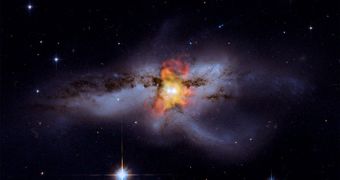In a groundbreaking, new image, astronomers and astrophysicists will finally have the opportunity to study one of the rarest events in the observed Universe, namely the collision and merger of two black holes. While it may be that the current generation, and many others after it, will not live to see it, the data collected so far is enough to run computer simulations on what “monstrosity” will be generated once the merger is complete, Wired reports.
The two supermassive black holes, which were previously imaged by the Hubble Space Telescope, are located at the core of the galaxy NGC 6240. The formation is located some 3,000 light-years away, and Hubble was used to snap an optical-wavelength photo of it. Recently, employing NASA’s Chandra X-ray Observatory, astronomers managed to obtain a new view of the galaxy's core, this time in X-ray wavelengths. The data from the two observatories was then combined to create an amazing composite picture that showed the inner workings of NGC 6240 in great detail.
Astronomers don't yet know when this will happen, but they are convinced that the two black holes are heading straight for each other, and believe that they will eventually merge into a single, even more massive one. These monsters can grow to be anywhere between hundreds of thousands to billions of times the mass of our Sun, and it is widely believed among astronomers that each massive galaxy, such as our Milky Way, has one at its core. Additionally, smaller ones roam the galaxy, minding their own businesses, and occasionally sucking in stars.
The new image, in addition to offering experts many hours of professional satisfaction, also highlights the level of development in photographic technology. The two superimposed photographs were taken at such high resolutions, considering the distance between the Earth and NGC 6240, that one could easily argue they were an artist' s rendering. However, they are not. Many photos of cosmic objects are actually composite images, created from data collected by more than one telescope, with the very point of bringing out various features in the analyzed object.

 14 DAY TRIAL //
14 DAY TRIAL //